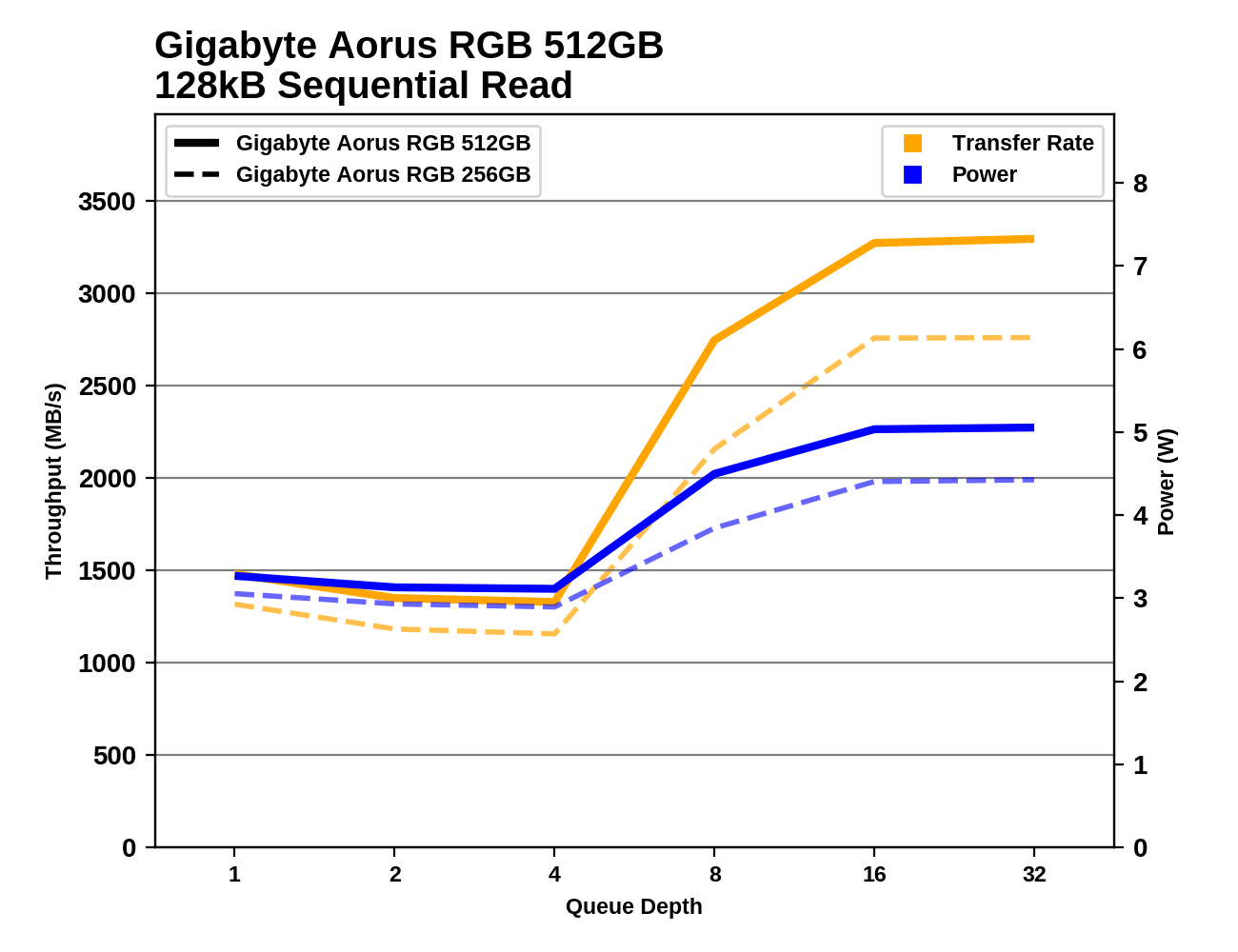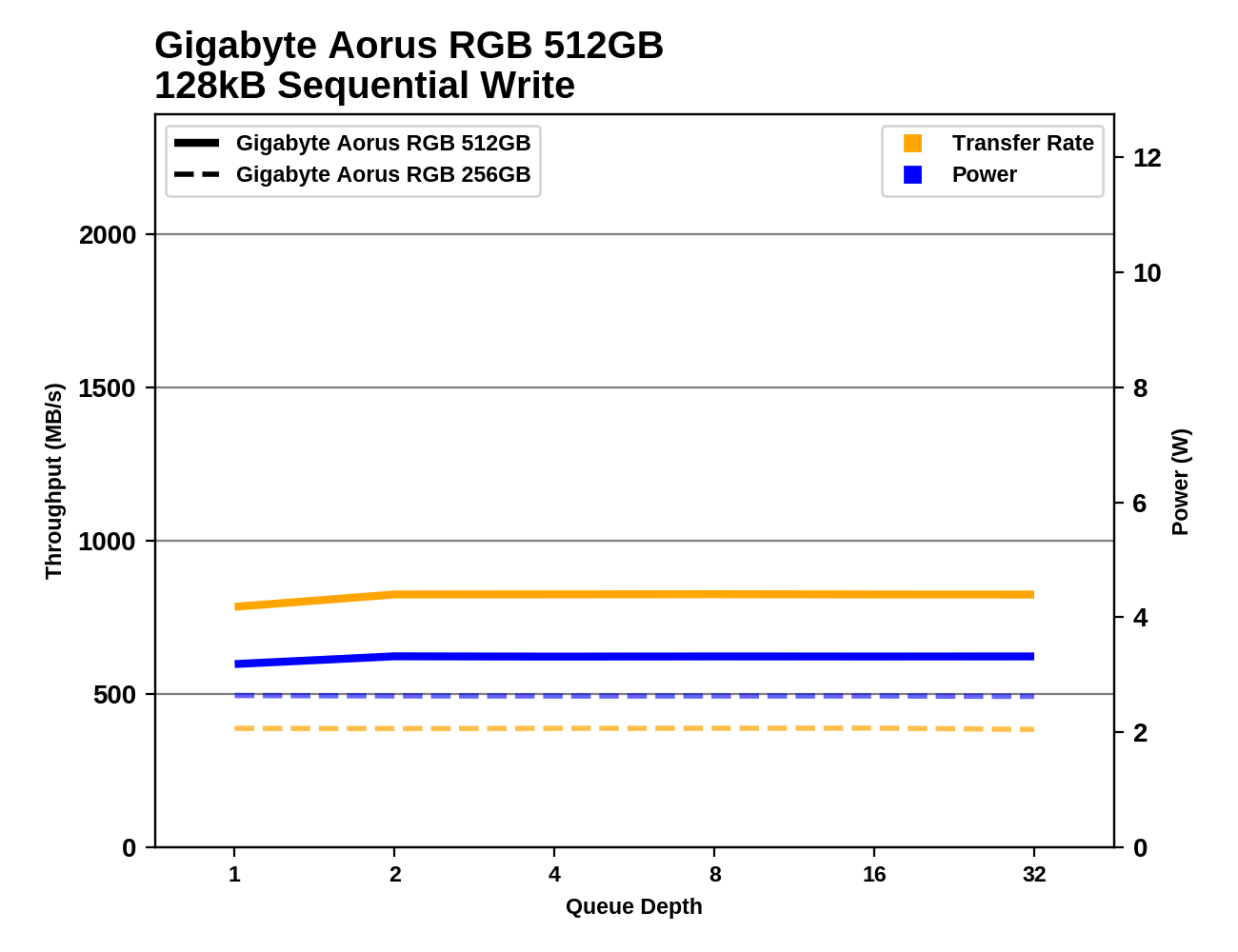The GIGABYTE Aorus RGB M.2 SSD Review: Nothing Is Too Small For RGB LEDs
by Billy Tallis on April 10, 2019 8:00 AM ESTSequential Read Performance
Our first test of sequential read performance uses short bursts of 128MB, issued as 128kB operations with no queuing. The test averages performance across eight bursts for a total of 1GB of data transferred from a drive containing 16GB of data. Between each burst the drive is given enough idle time to keep the overall duty cycle at 20%.

The QD1 burst sequential read performance of the GIGABYTE Aorus RGB SSDs is quite clearly in the high-end NVMe tier, but they are the slowest drives in this market segment with performance in the 1.8-1.9GB/s range compared to 2.4GB/s for the ADATA SX8200.
Our test of sustained sequential reads uses queue depths from 1 to 32, with the performance and power scores computed as the average of QD1, QD2 and QD4. Each queue depth is tested for up to one minute or 32GB transferred, from a drive containing 64GB of data. This test is run twice: once with the drive prepared by sequentially writing the test data, and again after the random write test has mixed things up, causing fragmentation inside the SSD that isn't visible to the OS. These two scores represent the two extremes of how the drive would perform under real-world usage, where wear leveling and modifications to some existing data will create some internal fragmentation that degrades performance, but usually not to the extent shown here.

On the longer sequential read test that goes a bit beyond QD1, the Aorus and other Phison E12-based SSDs fall well behind other recent high-end NVMe SSDs. However, the E12 drives do provide competitive performance when reading data that was not written sequentially.
 |
|||||||||
| Power Efficiency in MB/s/W | Average Power in W | ||||||||
The Aorus SSDs and other Phison E12 drives also lag behind other top NVMe drives on the power efficiency scores for the sequential read test, but it's not a large gap as it was for raw performance. In absolute terms, the Aorus SSDs only draw slightly more power than SATA SSDs or the entry-level NVMe drives based on the Phison E8.
 |
|||||||||
The Aorus SSDs continue the pattern of Phison E12 drives requiring high queue depths before sequential read performance starts to improve beyond the QD1 performance; this is also evident to a lesser extent with Phison E8 drives, but most of the competition is at or close to its full speed by QD2.
 |
|||||||||
| 512 GB | 256 GB | ||||||||
At sufficiently high queue depths, the 512GB Aorus SSD provides reasonable performance and power efficiency for a high-end NVMe SSD, falling in the middle of the cluster of results that surpass 3GB/s. The smaller 256GB model doesn't quite get there in terms of performance, but when it does saturate it at least offers decent power efficiency for the speed.
Sequential Write Performance
Our test of sequential write burst performance is structured identically to the sequential read burst performance test save for the direction of the data transfer. Each burst writes 128MB as 128kB operations issued at QD1, for a total of 1GB of data written to a drive containing 16GB of data.

The 256GB and 512GB Aorus SSDs offer far less performance on the burst sequential write test than a 1TB drive using the same controller and flash, and the Aorus drives are also underperforming all the competition of comparable capacity. The 256GB Aorus even manages to be slower than the 256GB MyDigitalSSD SBX, based on the lower-end Phison E8 controller.
Our test of sustained sequential writes is structured identically to our sustained sequential read test, save for the direction of the data transfers. Queue depths range from 1 to 32 and each queue depth is tested for up to one minute or 32GB, followed by up to one minute of idle time for the drive to cool off and perform garbage collection. The test is confined to a 64GB span of the drive.

On the longer sequential write test that includes some higher queue depths, the Aorus SSDs are clearly faster than the entry-level NVMe drives but are not competitive with the top high-end drives. The ADATA SX8200 based on the Silicon Motion SM2262 is able to compete against Phison E12 drives twice its size on this test, and the Samsung drives also have a substantial lead over the Aorus SSDs.
 |
|||||||||
| Power Efficiency in MB/s/W | Average Power in W | ||||||||
The 512GB Aorus SSD has decent but not class-leading power efficiency on the sequential write test, but the 256GB model scores much lower, thanks to having less than half the raw performance. In spite of the RGB LEDs, the Aorus drives are still some of the lowest-power drives in the high-end NVMe market segment, but in cases like this test, that's because they're having a hard time keeping up with the competition.
 |
|||||||||
The performance of the Aorus SSDs during the sequential write test is quite flat across the range of queue depths. Each phase of the test writes more than enough data to fill the SLC cache, while the 1TB Silicon Power P34A80 with the same Phison E12 controller shows wild performance oscillations because its SLC cache size and best-case write speed are significantly larger.
 |
|||||||||
| 512 GB | 256 GB | ||||||||
The smaller 256GB Aorus SSD's performance and power consumption on the sequential write test are stuck down in SATA SSD territory. The larger 512GB model is fast enough to significantly outpace SATA drives, but among the broader field of NVMe competition it is unimpressive.










23 Comments
View All Comments
austinsguitar - Wednesday, April 10, 2019 - link
conclusion: its actually pretty good.Flunk - Wednesday, April 10, 2019 - link
At this point I think I'd pay a bit extra to NOT have non-functional LEDs on my computer hardware.FreckledTrout - Wednesday, April 10, 2019 - link
I like the idea of LED's but hate the cute way most get implemented. Vendors could make them all functional with a little effort. Change colors due to CPU temps, backlight ports and even change color on said back light when something gets plugged in. Color code audio ports with light. Im sure Im missing some. I actually don't mind being able to see into my case to check for dust bunnies or make sure fans are spinning without opening the case up.CheapSushi - Wednesday, April 10, 2019 - link
Or allow them to be Activity LEDs. :( None of the software implementations seem to allow this.CheapSushi - Wednesday, April 10, 2019 - link
You have practically hundreds of SSD choices. Stop whining.Thud2 - Wednesday, April 10, 2019 - link
Sorry, a bit off topic but seems the perfect place to ask. What is that below the eagles head? An arm? A huge jaw?Hxx - Wednesday, April 10, 2019 - link
good question. All i can tell u is that its derived from Horus (ancient Egypt). I know bc Gigabyte mentioned it in one of their early vidz. As far as what that thing is, likely a jaw resembling letter G, i dont believe its in arm.andychow - Wednesday, April 10, 2019 - link
The eagle is shaking his fist. Aorus (Horus) is a man with an eagle head, that's why he has arms and not wings. And he's shaking his fist because he's a bad-ass.philehidiot - Wednesday, April 10, 2019 - link
Yeh what Andychow said. Horus with the fist and bicep. He's such a badass that he's now stopped battling Set but is sponsoring SSDs instead. Because.... badass.Duwelon - Thursday, April 11, 2019 - link
An arm. Specifically,. a well-toned right arm, ready to go. Does Gigabyte know the types of people that want RBG on their M.2 drives or what?